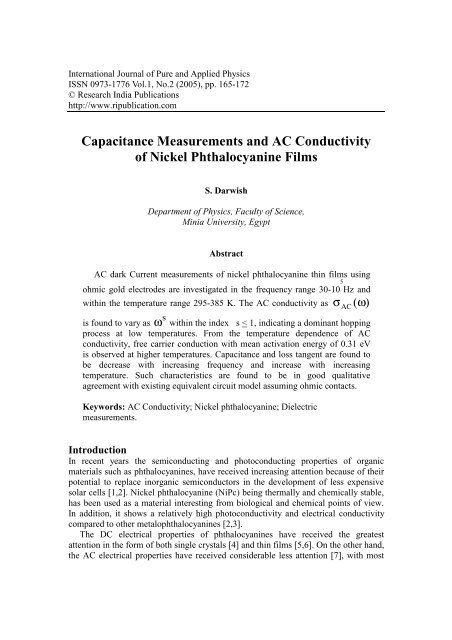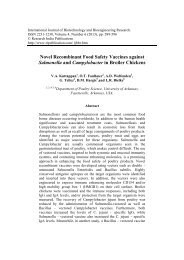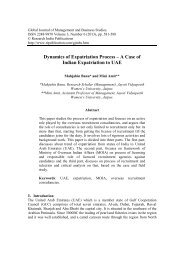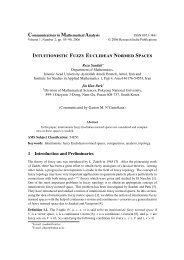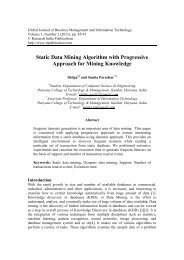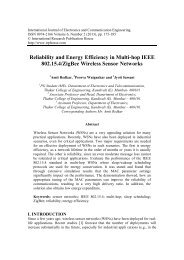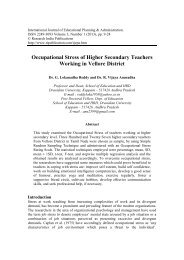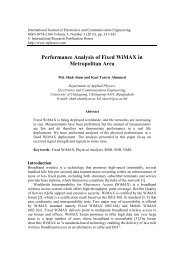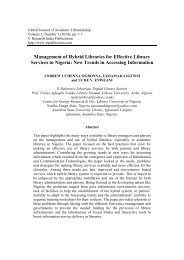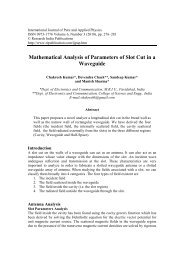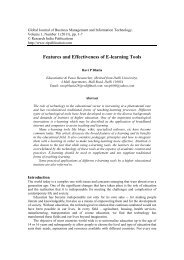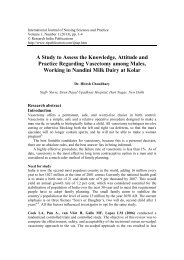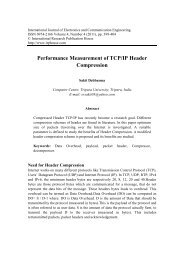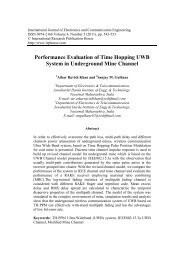Capacitance Measurements and AC Conductivity of Nickel ...
Capacitance Measurements and AC Conductivity of Nickel ...
Capacitance Measurements and AC Conductivity of Nickel ...
You also want an ePaper? Increase the reach of your titles
YUMPU automatically turns print PDFs into web optimized ePapers that Google loves.
International Journal <strong>of</strong> Pure <strong>and</strong> Applied PhysicsISSN 0973-1776 Vol.1, No.2 (2005), pp. 165-172© Research India Publicationshttp://www.ripublication.com<strong>Capacitance</strong> <strong>Measurements</strong> <strong>and</strong> <strong>AC</strong> <strong>Conductivity</strong><strong>of</strong> <strong>Nickel</strong> Phthalocyanine FilmsS. DarwishDepartment <strong>of</strong> Physics, Faculty <strong>of</strong> Science,Minia University, EgyptAbstract<strong>AC</strong> dark Current measurements <strong>of</strong> nickel phthalocyanine thin films usingohmic gold electrodes are investigated in the frequency range 30-10 5 Hz <strong>and</strong>within the temperature range 295-385 K. The <strong>AC</strong> conductivity as σ ( ω )sis found to vary as ω within the index s < 1, indicating a dominant hoppingprocess at low temperatures. From the temperature dependence <strong>of</strong> <strong>AC</strong>conductivity, free carrier conduction with mean activation energy <strong>of</strong> 0.31 eVis observed at higher temperatures. <strong>Capacitance</strong> <strong>and</strong> loss tangent are found tobe decrease with increasing frequency <strong>and</strong> increase with increasingtemperature. Such characteristics are found to be in good qualitativeagreement with existing equivalent circuit model assuming ohmic contacts.Keywords: <strong>AC</strong> <strong>Conductivity</strong>; <strong>Nickel</strong> phthalocyanine; Dielectricmeasurements.<strong>AC</strong>IntroductionIn recent years the semiconducting <strong>and</strong> photoconducting properties <strong>of</strong> organicmaterials such as phthalocyanines, have received increasing attention because <strong>of</strong> theirpotential to replace inorganic semiconductors in the development <strong>of</strong> less expensivesolar cells [1,2]. <strong>Nickel</strong> phthalocyanine (NiPc) being thermally <strong>and</strong> chemically stable,has been used as a material interesting from biological <strong>and</strong> chemical points <strong>of</strong> view.In addition, it shows a relatively high photoconductivity <strong>and</strong> electrical conductivitycompared to other metalophthalocyanines [2,3].The DC electrical properties <strong>of</strong> phthalocyanines have received the greatestattention in the form <strong>of</strong> both single crystals [4] <strong>and</strong> thin films [5,6]. On the other h<strong>and</strong>,the <strong>AC</strong> electrical properties have received considerable less attention [7], with most
166 S. Darwishwork to date focusing on metal - substituted phthalocyanines , such as metal - freephthalocyanine, H 2 Pc [7], copper phthalocyanine, CuPc[8], zinc phthalocyanine,ZnPc [9] <strong>and</strong> molybdenum phthalocyanine MoPc [10].The behavior <strong>of</strong> the <strong>AC</strong> conductivity, σ<strong>AC</strong>, in various phthalocyanine films wasascribed to the inhomogeneity within the solid caused by the absence <strong>of</strong> long - rangecrystalline order [7]. Carrier transport via a hopping mechanism was identified withthis type <strong>of</strong> dielectric response [11], <strong>and</strong> Jonscher [12] has proposed that such adependence represents a universal law, applicable to a very wide materialsirrespective <strong>of</strong> their chemical <strong>and</strong> physical structure <strong>and</strong> the type <strong>of</strong> dominant chargecarrier.<strong>Measurements</strong> <strong>of</strong> capacitance <strong>and</strong> loss tangent as a function <strong>of</strong> temperature <strong>and</strong>frequency have been performed on CoPc [13,14], CuPc [8] <strong>and</strong> ZnPc films [9].Generally, it was observed that the capacitance decreases with increasing freq uency<strong>and</strong> increases with increasing temperature; this was interpreted using existing theory,for the case <strong>of</strong> a thermally activated process when using ohmic contacts [13].In the present work, the <strong>AC</strong> conductivity, , capacitance, C, <strong>and</strong> loss tangent,tan δ, in purified α - NiPc thin films has been studied over a wide range <strong>of</strong>temperature (295-385 K) <strong>and</strong> frequency (30-10 5 Hz).σ<strong>AC</strong>ExperimentalThe powdered NiPc obtained from Easlman Kodak Ltd. NY, was purified two timesby the train sublimation technique using the method described previously [15]. Thepurified NiPc was examined spectroscopically. The infrared spectra were found to bein good agreement with those reported by Sidorov et al. [16] over the range 700 –13500 cm − indicating the α - phase material. However, the α - phase is metastable<strong>and</strong> obtained either as polycrystalline powder or as a thin film deposited attemperature less than approximately 573 K [17]. The α - NiPc layer was depositedby thermal evaporation from a molybdenum boat at pressures < 10 -5 Pa ontoprecleaned glass substrates coated with an evaporated gold (Au) electrode. Thedeposition rate was about 5nm / min <strong>and</strong> the thickness <strong>of</strong> NiPc ranged from 2 to 3µm. The resulting films were dried at room temperature in atmospheric pressure for24 h before the deposition <strong>of</strong> the top Au electrode. The completed devices had anactive area <strong>of</strong> ≈10 -4 m 2 . The electrical contacts were equipped with copper wiresmechanically applied to the metal electrodes <strong>of</strong> the specimen using "Radio spares"thermosetting silver paint.To investigate the dielectric properties a phase detector technique (lock - inamplifier, Stanford type SR 510) was used. The specimen was placed in a holderspecially designed to minimize stray capacitance. Temperatures were measured usinga NiCr-NiAl thermocouple mounted in close proximity to the sample <strong>of</strong> interest,which could be read out on a Keithley 871 digital thermometer display.
<strong>Capacitance</strong> <strong>Measurements</strong> <strong>and</strong> <strong>AC</strong> <strong>Conductivity</strong>167Results <strong>and</strong> DiscussionThe capacitance <strong>of</strong> NiPc films as a function <strong>of</strong> frequency, f , is measured at differenttemperatures. Fig. 1 shows the results for a sample <strong>of</strong> thickness 2.5 µm . It can beseen from this figure that the capacitance is frequency dependent at relatively hightemperatures <strong>and</strong> low frequencies, approaching a constant value at higher frequenciesirrespective <strong>of</strong> temperature. Similar results have been obtained for thin films for CuPc[8], ZnPc[9],MoPc [10], H 2 Pc[7] as well as pellets <strong>of</strong> CoPc [18]. These results wereadequately interpreted in terms <strong>of</strong> an equivalent circuit model proposed by Goswami<strong>and</strong> Goswami [19] which has been invoked to explain the <strong>AC</strong> characteristics <strong>of</strong> CuPcfilms with Au electrodes [8]. Since the Au electrodes are ohmic they do not give riseto Schottky barriers <strong>and</strong> are thus represented in the model by a small series resistance,r. The dielectric layer is represented by a frequency-independent capacitive elementC′ in parallel with a temperature-dependent resistive element R. According to thismodel the measured353025T= 295KT= 318KT= 325KT= 360KT= 385K20C s(nF)15105010 3 10 4 10 5f (Hz)Figure 1. <strong>Capacitance</strong> dependence <strong>of</strong> frequency at different temperatures.series capacitance, C s , is given byAnd the loss tangent byCC′+ω1s = (1)2 2RC′1+r/Rtan = + ω r C′ω R C′δ (2)where ω is the angular frequency. Eq. (1) Predicts thatC s should decreasewith increasing ω eventually tending to a constant value C′ for all temperatures<strong>and</strong> for ω • î 5 s -1 . On the other h<strong>and</strong> C s will increase with increasingtemperature because <strong>of</strong> the decreasing value <strong>of</strong> R. All <strong>of</strong> these effects are clearly
168 S. Darwishtan δ (Eq. (2)) predicts a decease in tan δobserved in Fig.1. The expression <strong>of</strong>−1with increasing ω where the term ω is dominant for lower frequencies, followed1/2by a loss minimum at ω min ≈1/[C ′(rR)] [1,6] <strong>and</strong> finally to increase withω above ω min where the term in ω is dominant.The variation <strong>of</strong> tan δ with frequency at various temperatures is representedin Fig. 2. The decrease <strong>of</strong> tan δ with frequency is clearly evident as predicted forlow frequencies <strong>and</strong> no indication <strong>of</strong> a minimum is observed over the frequency10 2 T= 295K10 1tan δ10 010 -1T= 318KT= 325KT= 360KT= 385K10 -210 3 10 4 10 5f (Hz)Figure 2: Dependence <strong>of</strong> loss tangent on frequency at different temperatures.range investigated. However, further work is aimed at extending the measurementsto higher frequencies <strong>and</strong> temperatures employed in an attempt to observe welldefinedminima in tan δ as predicted by the model <strong>of</strong> Goswami <strong>and</strong> Goswami [19].It is also hoped to investigate dielectric losses at very low frequencies in otherorganic materials. On the other h<strong>and</strong>, it can be seen from Fig. 2 that tan δ increaseswith the increase <strong>of</strong> temperature at all frequencies. The increase in tan δ with−1temperature is consistent with Eq. (2) as the ω term becomes dominant because <strong>of</strong>the decreasing value <strong>of</strong> R with temperature.The frequency dependence <strong>of</strong> the <strong>AC</strong> conductivity ( σ <strong>AC</strong> = σ − σDC) fordifferent values <strong>of</strong> temperatures is shown in Fig. 3. The conductivity obeyed theempirical law <strong>of</strong> frequency dependence given by the power law <strong>of</strong> the form [8,20]:sσ <strong>AC</strong>( ω)= Aω(3)the variation <strong>of</strong> the exponent s with temperature gives information on the specific
<strong>Capacitance</strong> <strong>Measurements</strong> <strong>and</strong> <strong>AC</strong> <strong>Conductivity</strong>169mechanism involved. As can be seen from Fig. 3, the value <strong>of</strong> s was found to bedecreased from 0.55 to 0.45 with increasing the temperature from 295 to 325 K. Athigh temperatures the conductivity becomes almost frequency independent over thefrequency range <strong>of</strong> interest. In the case <strong>of</strong> the transport processes in disordered media[21], the low- frequency conductivity has the same frequency dependence asobserved in the NiPc films, which characterizes a hopping mechanism <strong>of</strong> conduction[22]. This view is found in high purity H 2 Pc [7] where σ <strong>AC</strong> was measured <strong>and</strong> thehopping mechanism <strong>of</strong> the charge carrier transport was uncritically concluded, whilethere is no other evidence to support such a statement <strong>and</strong> <strong>of</strong>ten there is ampleevidence that cannot be the case. However, <strong>AC</strong> conductivity having a frequencydependence in the form <strong>of</strong> Eq. (3), where s < 1, has been observed in manynoncrystalline materials [8]. Abkowitz et al. [23] observed a similar sublinearfrequency- dependent conductivity for both crystalline <strong>and</strong> amorphous As 2 S 3 <strong>and</strong>have associated this behavior with the displacement <strong>of</strong> charge in localized electronicstates, resulting from defects, impurities or internal micro- interfaces. PolycrystallineH 2 Pc [7] as well as crystalline anthracence [23] have also been shown to exhibit asimilar type <strong>of</strong> frequency- dependent conductivity. James et al. [10], for example,have observed an index <strong>of</strong> approximately 0.9 in MoPc films at room temperature. Onthe contrary, Blagodarov et al. [24] have noticed a very weak frequency dependence<strong>of</strong> the σ <strong>AC</strong> <strong>of</strong> H 2 Pc thin films that disappeared when a constant voltage was appliedacross the films. They ascribe such an effect to the domination <strong>of</strong> a b<strong>and</strong> conductionmechanism in this case.-5.8-6.0-6.2log σ Ac-6.4-6.6-6.8T= 295KT= 310KT= 318KT= 325KT= 360KT= 368KT= 385K-7.02.5 3.0 3.5 4.0log fFigure 3. Dependence <strong>of</strong> frequency on the <strong>AC</strong> conductivity at different temperatures.The electrical conductivityfrequency is given by [2,12]:σ <strong>AC</strong> as a function <strong>of</strong> temperature at constant
170 S. Darwishσ <strong>AC</strong> = B exp (-Ec/ kT)(4)where B is constant <strong>and</strong> E c the activation energy for conduction. Thesemilogarithmic relation <strong>of</strong> Eq. (4) for different frequencies are shown in Fig. 4. Thisfigure illustrates that σ<strong>AC</strong>is dependent on the frequency below approximately 325 K<strong>and</strong> is associated with very low- activation energies. Such behavior has previouslybeen ascribed to conduction by hopping <strong>of</strong> charge carriers between localized states invarious inorganic materials [26] as well as ZnPc[9], CuPc [8], H 2 Pc [7] <strong>and</strong> ironphthalocyanine, FePc [27].At temperature above 325 K, the conductivity becomes progressivelyfrequency independent but increases more rapidly with temperature. This variation inthe conductivity may be caused by charge transport through extended energy b<strong>and</strong>s[8]. The values <strong>of</strong> E c calculated from Eq. (4) is essentially independent <strong>of</strong> frequency<strong>and</strong> <strong>of</strong> a value = 0.31 + 0.03 eV. This value is in good agreement with the values <strong>of</strong>0.30, 0.29 <strong>and</strong> 0.33 eV reported by Gould et al. [8], Saleh et al. [2] <strong>and</strong> by Riad et al.[7] for CuPc, ZnPc <strong>and</strong> H 2 Pc, respectively, <strong>and</strong> may therefore also be associatedwith impurities such as oxygen molecules that behave as acceptor levelssituated above the valence b<strong>and</strong> edge [9]. Such impurities are expected to give rise tocarriers <strong>and</strong> free b<strong>and</strong> conductivity in the temperature range <strong>of</strong> 325-385 K. However,a great number <strong>of</strong> localized states is expected to exist in NiPc but their density isincapable <strong>of</strong> dominating the statistics.500 Hz1 kHz2 kHz10 -6σ <strong>AC</strong>(Sm -1 )10 -72.6 2.8 3.0 3.2 3.410 3 /T (K -1 )Figure 4. Semilogarithmic plots <strong>of</strong> <strong>AC</strong> conductivity against reciprocal <strong>of</strong> temperatureat three different frequencies.The temperature dependence <strong>of</strong> the model shown in Eq.(1) is represented via athermally activated process, with the formula
<strong>Capacitance</strong> <strong>Measurements</strong> <strong>and</strong> <strong>AC</strong> <strong>Conductivity</strong>171R = R o exp( ∆E/kT)(5)where R ois constant <strong>and</strong> ∆ E the activation energy. The calculated value <strong>of</strong> Rcould be employed to shed light on the variation <strong>of</strong> the DC conductivity, σDC, <strong>of</strong>NiPc films with temperature. Fig. 5 shows a plot <strong>of</strong> logσ DCversus 1/T <strong>of</strong> NiPcfilms. The slope <strong>of</strong> this curves gives E = 0.28 + 0.02 eV, while the intercept gives5.8×10 -3 Sm -1 . Therefore, it is clear that the activation energy value for σ<strong>AC</strong>at hightemperaturerange, is close to that for σ DC( within the experimental error),indicating that σ <strong>AC</strong>is mainly determined by the temperature since free-carrierconduction became dominant. On the other h<strong>and</strong>, the disagreement between theactivation energy value <strong>of</strong> σ<strong>AC</strong>at lower temperature <strong>and</strong> that for σDCsuggestedthat the hopping mechanism plays an important role for the conduction process in the<strong>AC</strong> measurements. Therefore, the activation energy for σ <strong>AC</strong>required for thehopping mechanism in the NiPc films is assumed to be quite low.-5.8-6.0-6.2-6.4log σ DC-6.6-6.8-7.0-7.22.6 2.7 2.8 2.9 3.0 3.1 3.2 3.3 3.4 3.510 3 /T (K -1 )Figure 5: Temperature dependence <strong>of</strong> DC conductivity.Summary <strong>and</strong> conclusionsα - NiPc thin films s<strong>and</strong>wiched between gold electrodes have shown similar <strong>AC</strong>conductivity <strong>and</strong> dynamic characteristics as found in some other metal phthalocyaninematerials. The <strong>AC</strong> conductivity generally shows a σ ( ω ) . sω dependencewhere s < 1, indicating that hopping is the predominant conduction process at lowertemperatures. At higher temperatures, a thermally-activated free b<strong>and</strong> process with a<strong>AC</strong>
172 S. Darwishmean activation energy <strong>of</strong> §H9LVREVHUYHG%RWKFDSDFLWDQFHDQGORVVWDQJHQWare found to be decrease with increasing frequency <strong>and</strong> increase with increasingtemperature. Such behavior has been shown to be in qualitative agreement with themodel <strong>of</strong> Goswami <strong>and</strong> Goswami [19]. Clearly, although this model predicts thegeneral features shown in the present work, even better agreement would requirerefinements to the model to include perhaps the effects <strong>of</strong> the intergranularcapacitance in the NiPc films or the effects <strong>of</strong> temperature on the series resistance, r.References[1] T.D Anthopoulos, T.S.Shafai, Thin Solid Films 441 (2003) 207.[2] A.S.Riad, Physica B270 (1999) 148.[3] T.D Anthopoulos, T.S.Shafai, J.Phys. Chem.Solids 64(2003)1217.[4] A.S.Riad, A.E.El-Sahmahy, S.M.Khalil, Physica B 215 (1995)217.[5] T.D Anthopoulos, T.S.Shafai, J.Phys. Chem. Solids 65 (2004)1345.[6] S.Ambity, C.S.Menon, Materials Letters 34 (1998) 124.[7] A.S.Riad, M.T.Korayem, T.G.Abdel-Malik, Physica B 270 (1999) 140[8] R.D.Gould , A.K. Hassan, Thin Solid Films 223 (1993) 334.[9] A.M.Saleh, R.D.Gould, A.K.Hassan, Phys.Stat.Sol. A 139 (1993)379.[10] S.A.James, A.K.Ray, S.Silver, Phys.Stat. Sol.A 129(1992) 435.[11] T.G.Abdel-Malik, M.E.Kassem, N.S Aly, S.M.Khalil, Acta Physica PhysicaPolonica A81 (4) (1992) 675.[12] A.K. Jonscher, Thin Solid Films 36 (1976) 341.[13] S.I. Shihub, R.D.Gould, Thin Solid Films 254 (1995) 187.[14] S.I. Shihub, R.D.Gould, S.Gravano, Physica B 222 (1996)136.[15] G.A.Cox, T.G.Abdel-Malik, J.Phys. C.10 (1977) 63.[16] A.N.Sidorov, I.P.Kothyar, Opt.Spectros. 11 (1961)92.[17] A.Twarowski, J.Chem.Phys. 77 (1982) 4698.[18] H. S. Nalwa, P. Vasudevan, J. Mater. Sc. Lett. 2 (1983)22.[19] A. Gosuami, A. P. Goswami, Thin Solid Films 16 (1973) 175.[20] K. Morii, H. Kawano, I. Fujii, T. Matsui, Y. Nakayama, J. Appl. Phys. 78 (3)(1995) 1914.[21] R. Kawshima, M. Satoh, J. Phys. Soc. Jpn. 59 (1990) 3635.[22] S. R. Elliott, Solid State Ion. Diffusion Reaction 27 (1988) 131.[23] M. Abkowitz, D. F. Blossey, A. I. Lakatos, Phys. Rev. B12 (1975) 3400.[24] A. N. Blagodarov, E.L. Lutsenko, L.D. Rozinshtein, Sov. Phys. Solid State 11(1970) 2747.[25] M. El- Shabasy, A. S. Riad, Physica B 222 (1996) 153.[26] T.T Al-Dahhan, C. A. Hogarth, Int. J. Electron. 63 (1987) 707.[27] J. Le Moigne, R. Even, J. Chem. Phys. 83 (1985) 6472.


